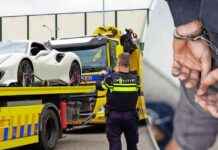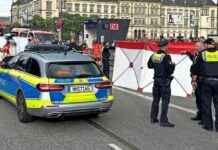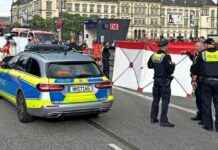Fritz-Julius Lemp is afraid. The 26-year-old commander of U-30 sees a relatively large and fast vessel to starboard abeam of his surfaced Type VIIA submarine, sailing obscured well north of the usual routes in the eastern Atlantic. Straight towards him.
It is Sunday, September 3, 1939 at approximately 7:10 p.m. Greenwich Standard Time. For a good five hours, Lemp and his boat have had the order “submarine trade war initially according to the operational plan”. Great Britain declared war on the German Reich after the London government’s ultimatum to Hitler to withdraw the Wehrmacht from Poland expired without effect.
“According to the operational plan” means according to the traditional “prize order”: civilian ships may only be attacked after a warning; the crew must be given the opportunity to get to safety. Without warning, a submarine may attack only clearly identified enemy warships.
Lemp is afraid. Because he fears that the fast, darkened steamer could be an auxiliary cruiser of the Royal Navy. Or, even worse, a “Q-Ship,” a submarine trap. Supposed merchant ships that carry their heavy armament disguised on board and destroy a submarine that they want to force to surrender according to the prize order.
The Oberleutnant zur See decides to dive and go on an attack course. 20 minutes later it got even darker. Lemp peers through the smaller attack periscope; it offers a much more limited view than the large, though easier to spot, main periscope.
Soon after 7:30 p.m. he gives the order to use the mechanical fire control computer to determine the combination of the boat’s course and the right moment of launch so that the unguided and usually straight-ahead torpedo hits the target ship.
“Torpedoes go!” he orders. One of the two “eels”, as the submarine men called their weapons, rushes off. But the other gets stuck in the pipe. There is a risk that his magneto will detonate the explosive charge and destroy U-30. The torpedo crew frantically tried to eject the “eel”. When that succeeds, Lemp immediately dives to maximum depth because the defective torpedo spins through the water.
Because of this technical failure, U-30 is only indirectly aware that its first torpedo hit the port side in the middle of the darkened ship at 7:39 p.m. GMT. The 15,000-ton passenger liner Athenia trembled. The torpedo explosion alone kills an estimated 50 to 60 people, mostly in the engine room and third class.
The Athenia is a 16-year-old oil-fired turbine steamer that regularly operates the Glasgow-Montreal route. She has 1418 people on board, including 315 crew members. The ship was quite full because many people are leaving Europe in view of the impending war. This includes 311 US citizens.
When Captain James Cook left Glasgow at around 11:30 am on September 1, 1939, war was already raging in Poland, but Great Britain was not yet directly affected. After the declaration of war on Germany on September 3, 1939, things changed. Cook has therefore ordered a zigzag course to be run. But that doesn’t protect him from the torpedo from U-30. The SS Athenia is the first ship to be torpedoed in World War II.
Just a few minutes after the hit, the steamer captain realizes that his ship cannot be saved. He orders the evacuation. The “Athenia” has 26 wooden lifeboats that hold 1828 people, as well as 21 foldable life rafts for another 460 people. 1600 life jackets are on board. Since the ship is sinking slowly, there is enough time to rescue all survivors.
About half an hour after his order to fire, Lemp has U-30 surface. First he wants to carry out a surface attack, then he realizes that he has really attacked a civilian ship – the rescue measures leave no doubt about it. A clear violation of the prize rules, right on the first day of the war against Britain. A disaster.
Then his radio operator brings him an intercepted distress call: “SS ‘Athenia’ torpedoed. 56.42 North, 14.05 West”. This is exactly the position of U-30. There can be no doubt as to the identity of the hit steamer. Lemp makes a momentous decision: he goes in the opposite direction. And he also does not inform Commodore Karl Dönitz, the commander of the U-boats, by radio. Lemp is silent – and tells his crew not to say anything about the attack either.
Of course, the news about the sinking of the “Athenia” went around the world. A total of 118 people lost their lives, half in the torpedo explosion and half in the night and morning evacuation on the Atlantic, which was by no means harmless. Among them are 28 Americans.
For this reason, just a few days after the start of the war, there is a threat of the USA joining the side of Great Britain. Similar to how it was just averted in 1915 after the sinking of the RMS “Lusitania” by the Reich leadership at the time. This time, however, Berlin did not react defensively, as it had 24 years earlier, but aggressively: the Goebbels apparatus spread with great propaganda effort that the “Athenia” was not sunk by a German submarine at all. Blame the Nazis’ favorite enemy, Winston Churchill. Newspaper articles are written and brochures published to prove it.
Since the beginning of the war, the British naval blockade has cut off Germany’s supplies. Every ship in the Imperial Navy is threatened with sinking. The only major naval battle takes place off the Skagerrak.
Those: STUDIO_HH
On September 27, 1939, U-30 arrives in Wilhelmshaven. Officially, Lemp sank two ships, but he was silent about the “Athenia”. Now, privately, he admits his mistake to Dönitz. But the Third Reich was too committed publicly to admit the fatal mistake after the fact: Dönitz orders Lemp to falsify U-30’s logbook and remove the page with the correct information about the 3 September sinking.
He was not punished, but promoted to lieutenant captain and awarded the Iron Cross, second class. He dies in 1941 when the Royal Navy captures his new submarine U-110.
The case remained controversial until the summer of 1945, when the prisoner of war Adolf Schmidt, a former crew member of U-30, confessed under oath that Lemp torpedoed and sank a large ship in the eastern Atlantic on September 3, 1939. Schmidt also reports on the commander’s efforts to keep the error secret.
In the Nuremberg trial of the main war criminals, Karl Dönitz then confessed: “U-30 returned to the port around mid-September. I met the commander, Oberleutnant Lemp, at the lock in Wilhelmshaven as the boat entered the harbor and he immediately asked me for a private meeting. I saw immediately that he looked very unhappy and he immediately told me that he thought he was responsible for the sinking of the ‘Athenia’ in the North Channel area.”
You can also find “World History” on Facebook. We are happy about a like.
This article was first published in September 2019.




















